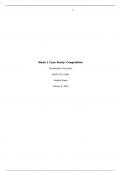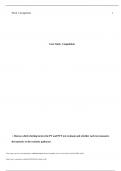Case study coagulation - Study guides, Class notes & Summaries
Looking for the best study guides, study notes and summaries about Case study coagulation? On this page you'll find 683 study documents about Case study coagulation.
Page 4 out of 683 results
Sort by
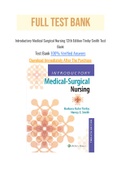
-
Introductory Medical Surgical Nursing 12th Edition Timby Smith Test Bank
- Exam (elaborations) • 1011 pages • 2022
-
- $26.48
- 4x sold
- + learn more
INTRODUCTORY MEDICAL SURGICAL NURSING 12TH EDITION TIMBY SMITH TEST BANK [Author name] [COMPANY NAME] [Company address] INTRODUCTORY MEDICAL SURGICAL NURSING 12TH EDITION TIMBY SMITH TEST BANK 1. CHAPTER 1 Managed care organizations are insurers that carefully plan and closely supervise the distribution of healthcare services. What is one of the goals of managed care? A) Preventing illness through screening and promotion of health activities B) Improving training of healthcare professionals C) E...

-
REHS/RS NEHA Study Guide – (2023/2024) Already Graded A
- Exam (elaborations) • 67 pages • 2023
- Available in package deal
-
- $11.99
- + learn more
REHS/RS NEHA Study Guide – (2023/2024) Already Graded A When gas pipe is leaking, what methods would be used by the technician to identify the exact point of leakage? Using soap bubble solution What is the graphic tool used by meteorologists to give a succinct view of how wind speed and direction are typically distributed at a particular location Wind Rose What is the lowest portion of Earth's atmosphere called: troposphere (a height of about 3.7-6.2 miles (6-10 km) What three viruses cau...
BIOS 255 Week 1 Assignment; Case Study - Coagulation

-
Jean Inman 17 RD prep Domain 1 Part 2 questions with correct answers|100% verified|46 pages
- Exam (elaborations) • 46 pages • 2024
-
- $15.99
- + learn more
Jean Inman 17 RD prep Domain 1 Part 2 questions with correct answers Dermatitis, diarrhea, dementia, pellagra are signs of a: a. riboflavin deficiency b. thiamin deficiency c. pyridoxine deficiency d. niacin deficiency Correct Answer-d. niacin deficiency What must be fortified with folic acid? a. skim milk b. cornmeal c. orange juice d. canned vegetables Correct Answer-b. cornmeal Pie crust is moist the day after cooking. Why? a. overcooking of the crust b. retrogradation of fil...
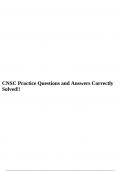
-
CNSC Practice Questions and Answers Correctly Solved!!
- Exam (elaborations) • 70 pages • 2023
- Available in package deal
-
- $12.99
- + learn more
CNSC Practice Questions and Answers Correctly Solved!! In an intensive care setting, which of the following complications associated with malnutrition is most likely to occur as a result of the failure to begin nutrition support early in the treatment regimen? - Answer Increased serum levels of protein-bound drugs Which of the following is the inpatient glycemic target for critically ill patients? 1: 80-110 mg/dL 2: 140-180 mg/dL 3: 181-210 mg/dL 4: 211-240 mg/dL - Answer 2: 140-180 mg/...
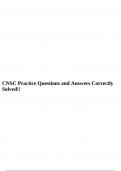
-
CNSC Practice Questions and Answers Correctly Solved!!
- Exam (elaborations) • 70 pages • 2023
- Available in package deal
-
- $12.99
- + learn more
CNSC Practice Questions and Answers Correctly Solved!! In an intensive care setting, which of the following complications associated with malnutrition is most likely to occur as a result of the failure to begin nutrition support early in the treatment regimen? - Answer Increased serum levels of protein-bound drugs Which of the following is the inpatient glycemic target for critically ill patients? 1: 80-110 mg/dL 2: 140-180 mg/dL 3: 181-210 mg/dL 4: 211-240 mg/dL - Answer 2: 140-180 mg/...
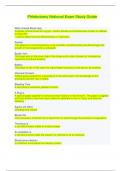
-
Phlebotomy National Exam Study Guide - Questions and Answers
- Exam (elaborations) • 19 pages • 2023
-
Available in package deal
-
- $15.49
- + learn more
Phlebotomy National Exam Study Guide - Questions and Answers ABG (Arterial Blood Gas) Analyses arterial blood for oxygen, carbon dioxide and bicarbonate content in addition to blood PH * used to determine the effectiveness or respiration Aseptic The absence of microorganisms or by contrast, something that just discourages the growth of microorganisms is antiseptic Basilic Vein The large vein on the inner side of the bicep and is often chosen for intravenous injections and blood drawing Battery ...
BIOS 255 Week 1 Assignment Case Study – Coagulation
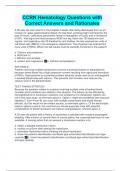
-
CCRN Hematology Questions with Correct Answers and Rationales
- Exam (elaborations) • 11 pages • 2024
-
- $9.99
- + learn more
A 52-year-old man returns to the hospital 2 weeks after being discharged from an ad mission for upper gastrointestinal bleed. He has been vomiting bright red blood for the past 24 hours. Laboratory parameters reveal a hemoglobin of 6 g/dL and a hematocrit of 20%. Vital signs are blood pressure 90/60 mm Hg; heart rate 120 beats/min and regular; and respiratory rate 22 breaths/min and shallow. He has received two units of red blood cells (RBCs) in the emergency department. The physician has order...
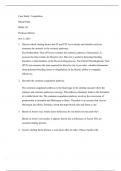
-
BIOS 255 Week 1 Case Study; Coagulation
- Case • 2 pages • 2023
-
- $15.49
- + learn more
1. Discuss which clotting factors the PT and PTT test evaluate and whether each test measures the intrinsic or the extrinsic pathways. The Prothrombin Time (PT) test evaluates the extrinsic pathway of hemostasis. It assesses the time it takes for blood to clot. This test is useful in detecting bleeding disorders or abnormalities in the blood clotting process. The Partial Thromboplastin Time (PTT) test measures the time required for blood to clot. It provides valuable information about pote...

How much did you already spend on Stuvia? Imagine there are plenty more of you out there paying for study notes, but this time YOU are the seller. Ka-ching! Discover all about earning on Stuvia

